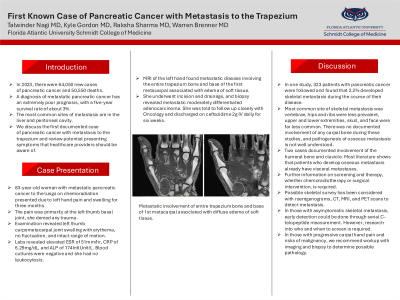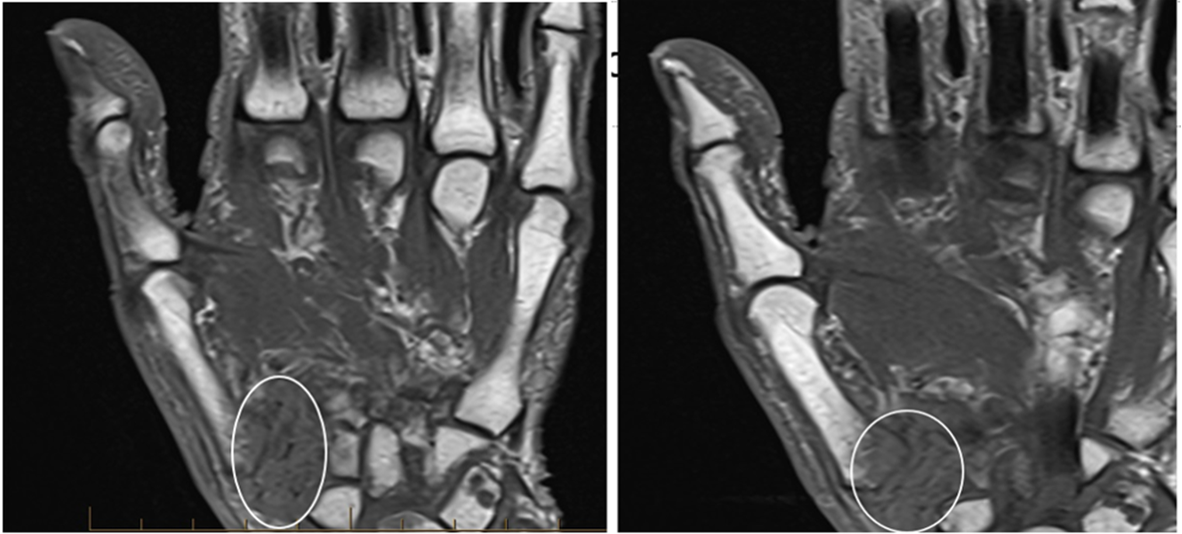Monday Poster Session
Category: Biliary/Pancreas
P1895 - First Known Case of Pancreatic Cancer With Metastasis to the Trapezium
Monday, October 28, 2024
10:30 AM - 4:00 PM ET
Location: Exhibit Hall E

Has Audio

Talwinder Nagi, MD
Florida International University
Boca Raton, FL
Presenting Author(s)
Talwinder Nagi, MD1, Kyle Gordon, MD2, Raksha Sharma, MD2, Elisheva Knopf, MS2, Warren Brenner, MD3
1Florida International University, Boca Raton, FL; 2Florida Atlantic University, Charles E. Schmidt College of Medicine, Boca Raton, FL; 3Baptist Health, Boca Raton, FL
Introduction: In 2023, there were 64,050 new cases of pancreatic cancer and 50,550 deaths. A diagnosis of metastatic pancreatic cancer has an extremely poor prognosis, with a five-year survival rate of about 3%. The most common sites of metastasis are in the liver and peritoneal cavity. We discuss the first documented case of pancreatic cancer with metastasis to the trapezium and review potential presenting symptoms that healthcare providers should be aware of.
Case Description/Methods: 83-year-old woman with metastatic pancreatic cancer to the lungs on chemoradiation presented due to left hand pain and swelling for three months. The pain was primarily at the left thumb basal joint, she denied any trauma. Examination revealed left thumb carpometacarpal joint swelling with erythema, no fluctuation, and intact range of motion. Laboratory was significant for elevated ESR of 51mm/hr, CRP of 6.29mg/dL, and ALP of 174IntlUnit/L. Blood cultures were negative and she had no leukocytosis. MRI of the left hand found metastatic disease involving the entire trapezium bone and base of the first metacarpal associated with edema of soft tissue. She underwent incision and drainage, and biopsy revealed metastatic moderately differentiated adenocarcinoma. She was told to follow up closely with Oncology and discharged on ceftazidime 2g IV daily for six weeks.
Discussion: In one study, 323 patients with pancreatic cancer were followed and found that 2.2% developed skeletal metastasis during the course of their disease. The most common site of skeletal metastasis was vertebrae, hips and ribs were less prevalent, upper and lower extremities, skull, and face were far less common. There was no documented involvement of any carpal bone during these studies, and pathogenesis of osseous metastasis is not well understood. Two cases documented involvement of the humeral bone and clavicle. Most literature shows that patients who develop osseous metastasis already have visceral metastases. Further information on screening and therapy, whether chemoradiotherapy or surgical intervention, is required. Possible skeletal survey has been considered with roentgenograms, CT, MRI, and PET scans to detect metastasis. In those with asymptomatic skeletal metastasis, early detection could be done through serial C-telopeptide measurement. However, research into who and when to screen is required. In those with progressive carpal hand pain and risks of malignancy, we recommend workup with imaging and biopsy to determine possible pathology.

Disclosures:
Talwinder Nagi, MD1, Kyle Gordon, MD2, Raksha Sharma, MD2, Elisheva Knopf, MS2, Warren Brenner, MD3. P1895 - First Known Case of Pancreatic Cancer With Metastasis to the Trapezium, ACG 2024 Annual Scientific Meeting Abstracts. Philadelphia, PA: American College of Gastroenterology.
1Florida International University, Boca Raton, FL; 2Florida Atlantic University, Charles E. Schmidt College of Medicine, Boca Raton, FL; 3Baptist Health, Boca Raton, FL
Introduction: In 2023, there were 64,050 new cases of pancreatic cancer and 50,550 deaths. A diagnosis of metastatic pancreatic cancer has an extremely poor prognosis, with a five-year survival rate of about 3%. The most common sites of metastasis are in the liver and peritoneal cavity. We discuss the first documented case of pancreatic cancer with metastasis to the trapezium and review potential presenting symptoms that healthcare providers should be aware of.
Case Description/Methods: 83-year-old woman with metastatic pancreatic cancer to the lungs on chemoradiation presented due to left hand pain and swelling for three months. The pain was primarily at the left thumb basal joint, she denied any trauma. Examination revealed left thumb carpometacarpal joint swelling with erythema, no fluctuation, and intact range of motion. Laboratory was significant for elevated ESR of 51mm/hr, CRP of 6.29mg/dL, and ALP of 174IntlUnit/L. Blood cultures were negative and she had no leukocytosis. MRI of the left hand found metastatic disease involving the entire trapezium bone and base of the first metacarpal associated with edema of soft tissue. She underwent incision and drainage, and biopsy revealed metastatic moderately differentiated adenocarcinoma. She was told to follow up closely with Oncology and discharged on ceftazidime 2g IV daily for six weeks.
Discussion: In one study, 323 patients with pancreatic cancer were followed and found that 2.2% developed skeletal metastasis during the course of their disease. The most common site of skeletal metastasis was vertebrae, hips and ribs were less prevalent, upper and lower extremities, skull, and face were far less common. There was no documented involvement of any carpal bone during these studies, and pathogenesis of osseous metastasis is not well understood. Two cases documented involvement of the humeral bone and clavicle. Most literature shows that patients who develop osseous metastasis already have visceral metastases. Further information on screening and therapy, whether chemoradiotherapy or surgical intervention, is required. Possible skeletal survey has been considered with roentgenograms, CT, MRI, and PET scans to detect metastasis. In those with asymptomatic skeletal metastasis, early detection could be done through serial C-telopeptide measurement. However, research into who and when to screen is required. In those with progressive carpal hand pain and risks of malignancy, we recommend workup with imaging and biopsy to determine possible pathology.

Figure: Metastatic involvement of entire trapezium bone and base of 1st metacarpal associated with diffuse edema of soft tissue.
Disclosures:
Talwinder Nagi indicated no relevant financial relationships.
Kyle Gordon indicated no relevant financial relationships.
Raksha Sharma indicated no relevant financial relationships.
Elisheva Knopf indicated no relevant financial relationships.
Warren Brenner indicated no relevant financial relationships.
Talwinder Nagi, MD1, Kyle Gordon, MD2, Raksha Sharma, MD2, Elisheva Knopf, MS2, Warren Brenner, MD3. P1895 - First Known Case of Pancreatic Cancer With Metastasis to the Trapezium, ACG 2024 Annual Scientific Meeting Abstracts. Philadelphia, PA: American College of Gastroenterology.
